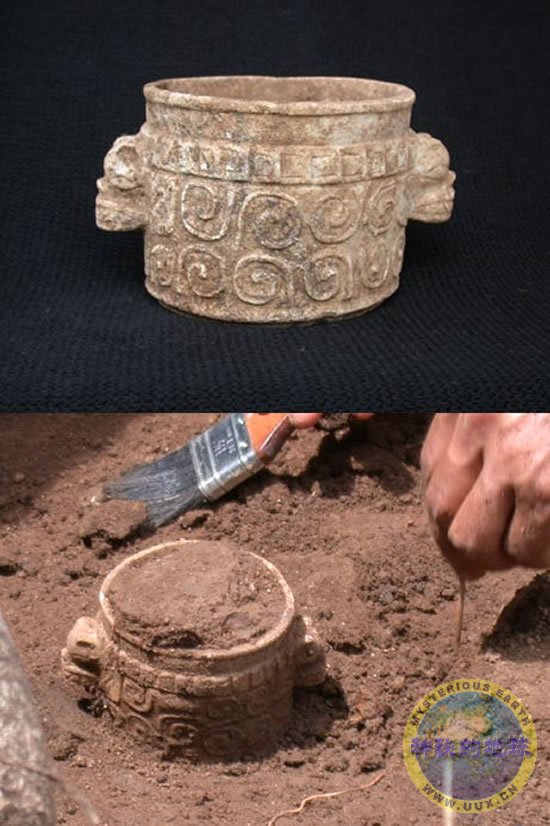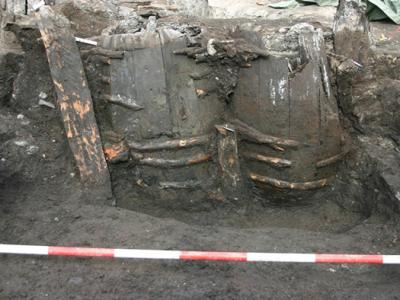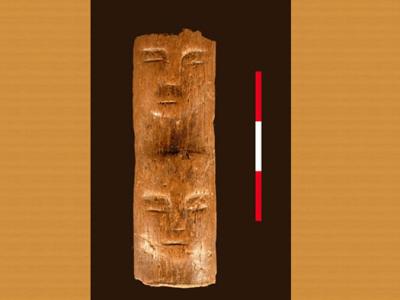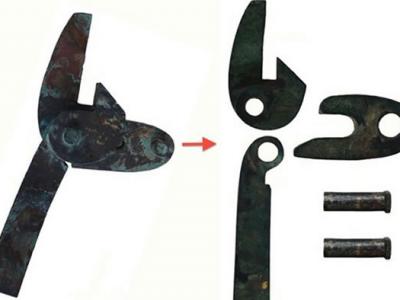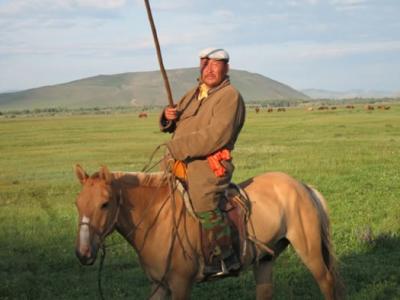Rare Maya "Death Vase" Discovered
This extremely rare "death vase" was recently discovered in the 1,400-year-old grave of a member of the Maya elite. The vase is carved with sculpted scrolls, overlapping tiles meant to resemble serpent scales, and handles fashioned into the shape of bats' heads.
The vase was discovered in Honduras by a team of archaeologists from the University of South Florida.
Photograph by Karla Davis-Salazar, courtesy Christian Wells
Blake de Pastino
National Geographic News
December 3, 2007
An extremely rare and intricately carved "death vase" has been discovered in the 1,400-year-old grave of a member of the Maya elite, scientists say.
The vase is the first of its kind to be found in modern times, and its contents are opening a window onto ancient rituals of ancestor worship that included food offerings, chocolate enemas, and hallucinations induced by vomiting, experts say.
Archaeologists discovered the vase along with parts of a human skeleton while excavating a small "palace" in northwestern Honduras in 2005. (The dig was funded by the National Geographic Society, which owns National Geographic News.)
Soil samples taken from in and around the vessel were found to contain pollen from corn, cacao, and false ipecac, a plant that causes severe nausea when eaten.
These traces suggest the vase may have been used in ancient rites the Maya practiced to produce trancelike states through intense physical purging, said Christian Wells, an anthropologist at the University of South Florida who lead the excavation.
"The way to have contact, to communicate, with ancestors is to have visions," Wells said of the Maya rituals.
"And you have a vision either by cutting yourself and bloodletting—which there's really no evidence for in this case—or by having some very powerful chocolate enema, or by drinking your brains out and throwing up.
"We think this beverage [in the vase] may have contained ipecac, which would have made the person who's drinking it throw up—a lot. Then, by throwing up a lot, they could've had visions that would have allowed them to talk with the ancestors."
Mysterious "Palace"
Wells' team believes that the white marble vase contained a corn-based gruel laced with the stomach-churning herb. Cacao, from which chocolate is made, may have been added for flavor.
The new findings could solve the long-standing mystery of what purpose the ornamental vessels, called Ulúa-style vases, served.
Most of the vases known to scientists were either looted from graves or were unearthed long before modern archaeological methods were available, Wells said.
"It's really the first one that has ever been excavated [scientifically]," Wells said. "Until this case, we hadn't really had any idea about how these items were used."
Although the archaeologists may have uncovered the vase's purpose, they are still perplexed by where they found it—beneath a pyramid-like palace they discovered in a small, remote Maya settlement in Honduras' Palmarejo Valley (see map).
"It's a terraced building, and it had a single room on top—a long, narrow, rectangular room," Wells said of the newfound structure. "It was like a house, but a very nice one."
Both the palace and the vase suggest a level of prestige that seems out of keeping with what was otherwise an unremarkable farming village, he added.
"Compared to other sites in the region, this one's pretty small, pretty unimpressive. So why is this very super high-status product in this burial in this residential building?"
The team suspects that the person buried beneath the palace was of historic importance to local residents, likely an ancestor figure whose death marked the end of an era.
"An ancestor is an important person who could've been a founder of the community or a founder of the lineage of the ruling family," he said.
The palace was built over the grave very soon after the burial took place, around A.D. 650, Wells said.
The vase was added to the grave about a hundred years after the burial, he added, likely to commemorate the ancestor's death.
"You typically see people digging up original ancestor figures and taking a relic bone or adding things to the [grave] and honoring them many years after they've died," Wells explained.
The nausea-inducing gruel that the vase likely held may have been drunk by a worshipper at such a ceremony, Wells said, or it may have been left as an offering to the dead.
But the most valuable gift may have been the vase itself.
A little larger than a coffee mug, the vessel is inscribed with sculpted scrolls and overlapping tiles resembling serpent scales, and each of its two handles is carved to resemble the head of a leaf-nose bat.
"These things were super labor-intensive to produce, and they had imagery that was very cosmically significant," Wells said.
The ornate vase may have found its way to the remote community through an ancient kind of social networking—in this case, by a valuable link to craftspeople who made these vessels in the Ulúa Valley, about a two-day walk away, Wells said.
"It could be that these kinds of marble vases ended up all over the place, and we just don't know because we haven't excavated them. But I suspect that there's something else going on here," he said.
"There's some special relationship that somebody had in this community with the producers of these vases over in the Ulúa Valley.
"This is something you would find in a Maya king's tomb," he added. "This is not something you would find in a very rural, backwater community."
(Read related story: "Ancient Maya Tomb Found: Upright Skeleton, Unusual Location" [May 17, 2007].)
Wells' colleagues Karla Davis-Salazar and Jose Moreno-Cortes presented the team's findings last month at the Southeast Conference on Mesoamerican Archaeology and Ethnohistory in Columbia, South Carolina.
Maize Beer
Christina Luke is an archaeologist at Boston University and an expert in Ulúa-style vases.
She said the discovery made by Wells' team is "very significant."
"Their vase is the best we have for really, really good context, excavated by professional archaeologists," she said.
Unlike vases unearthed a century ago, often by mining and railroad workers, "with this one, we know the exact context and where it was found," Luke said.
The pollen found with the vase seems consistent with ceremonial drinks used by the ancient Maya, she added.
"It makes sense to me that the vase would have been used for some sort of consumption of a fermented frothy drink," she said. "I'd say either a maize beer or a chocolate drink or some combination of the two.
To suggest that the vase was used in a purging ritual, however, "is stretching things a bit," she said.
While ancient Maya are known to have practiced ceremonial enemas and vomiting rites, there's little evidence that they were performed in the region where the vase was found, she said.
"I don't know the data that you would draw on to say that there were definitely purging rituals [in that community]," Luke said.
"The ipecac may suggest that, but I'd be uncomfortable saying, Yes, it's 100 percent what's going on."
Wells agreed that it's not certain that the newfound cup held a vomit-inducing beverage based solely on the few grains of ipecac pollen found in it. But he said his theory is consistent with rituals conducted in the region, as depicted on painted vessels found from the period.
"We can only entertain the possibility and seek further evidence to evaluate the idea," he said.
His team plans to return to the Palmarejo Valley next summer to learn more about the site's role in the Maya world and to determine whether more vases or palaces might yet be discovered.
"My sense is that this vase is very unique to this special burial, this special building," he said.
"But I'm wondering now what would we find in these other buildings."
